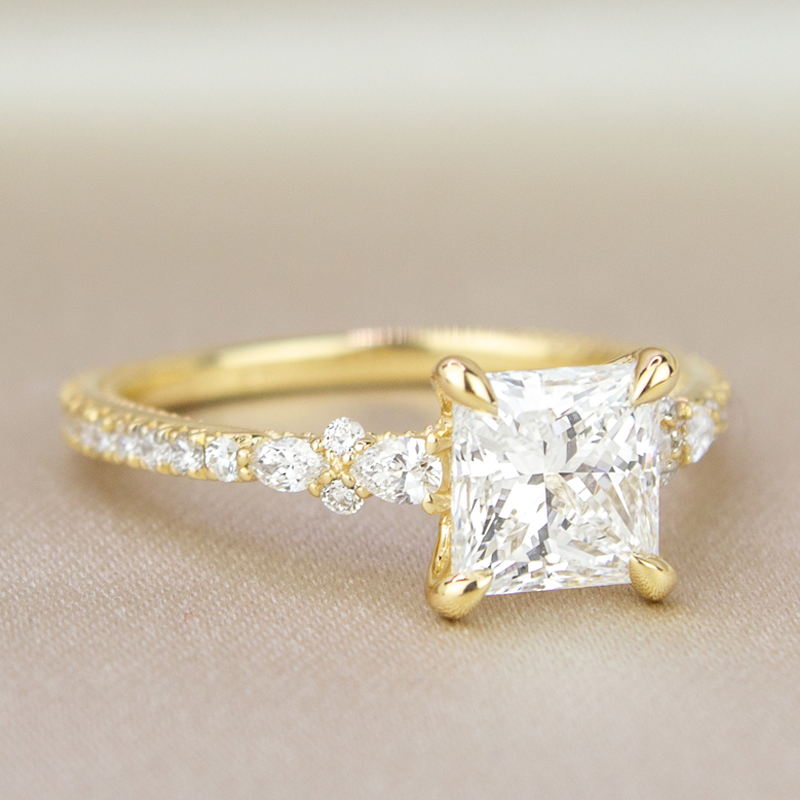
When it comes to choosing a diamond shape, the cushion cut and the princess cut are two popular options that are often compared. While both cuts are stunning, they differ in their overall appearance, sparkle, and style. Here’s a breakdown of the key differences.
Cushion Cut vs. Princess Cut: Appearance
Cushion: The cushion cut is characterized by its soft, rounded corners and a square or elongated shape, giving it a pillow-like appearance (hence the name). This cut has been a favorite since the 19th century and is often regarded for its vintage charm. The cushion cut combines aspects of the round brilliant and old mine cuts, offering a look that blends traditional elegance with a contemporary edge. Its rounded edges create a soft aesthetic, making it ideal for those seeking a more classic look.
Princess: The princess cut, on the other hand, is known for its sharp, defined corners and square or slightly rectangular shape. Developed in the 1960s, the princess cut is a relatively modern option, known for its geometric, sleek look. It maintains a square or rectangular shape when viewed from above, and when set in a ring, its clean lines and sharp angles create a striking, contemporary appearance. It is one of the most popular cuts today, particularly among those who prefer a more structured, modern style.
Cushion Cut vs. Princess Cut: Sparkle
Cushion: Cushion cuts can have larger facets, which often create a “chunkier” sparkle. They reflect light differently depending on whether they have a more vintage or modern cut. Cushion cuts with a “modified” brilliant pattern tend to have more fire (colored flashes of light), while more vintage cushion cuts have a softer, more romantic glow.
Princess: The princess cut is known for its exceptional brilliance. It uses a brilliant facet arrangement, similar to the round brilliant cut, which allows it to reflect light in an eye-catching way. Due to its intricate faceting, the princess cut maximizes light return, giving it a high level of sparkle. This makes it an ideal choice for those who prioritize brilliance and want a square or rectangular diamond.

Cushion Cut vs. Princess Cut: Style
Cushion: The cushion cut is often associated with vintage-inspired designs. Its soft corners and pillow-like shape lend themselves well to classic and antique settings, such as halos or pavé bands. The cushion cut’s versatility makes it popular in both modern and traditional styles, and its rounded edges give a softer, more delicate appearance. Brides who appreciate old-world charm or a more romantic, timeless look often gravitate towards cushion cut rings.
Princess: Princess cuts tend to offer a sleek, contemporary appearance. The clean lines and sharp angles work well in modern settings, such as prong or channel settings, which highlight the diamond’s defined structure. Princess cut diamonds also pair beautifully with minimalist settings or bold, geometric designs.
Cushion Cut vs. Princess Cut: Durability
Cushion: With rounded edges, cushion cuts are less prone to chipping, making them a more durable choice, especially for those with an active lifestyle.
Princess: The pointed corners of the princess cut can be more susceptible to damage, especially if not protected by the setting. This shape may require a more protective setting, like prongs or a bezel, to ensure the corners are safeguarded.

Cushion Cut vs. Princess Cut: Price
Cushion: Cushion cuts can be more affordable than princess cuts because they retain more of the rough diamond during the cutting process. The extra retained carat weight translates to a lower price per carat.
Princess: Princess cuts can be slightly more expensive than cushion cuts due to their popularity and the complexity of cutting. However, they still offer a great balance between brilliance and price when compared to other shapes.
Pros and Cons to Consider
Cushion Cut Pros and Cons
- Pro: Soft, romantic shape: Ideal for vintage-inspired or classic designs.
- Pro: Lower price per carat: Sometimes more affordable compared to princess cuts.
- Pro: Durable edges: Rounded corners may make it less prone to chipping.
- Con: Less brilliance: May not be as sparkly as the princess cut.
- Con: Chunky light performance: Larger facets can produce a softer glow, which may not appeal to those seeking intense sparkle.
Princess Cut Pros and Cons
- Pro: Exceptional brilliance: Known for its dazzling sparkle and light return.
- Pro: Sharp, modern look: Geometric lines make it perfect for contemporary styles.
- Pro: Square shape: For those wanting a structured, sleek diamond without sacrificing brilliance.
- Con: Vulnerable corners: The sharp points can be prone to chipping if not properly protected.
- Con: Higher price per carat: Can be more expensive due to cutting process and diamond loss.

Cushion Cut vs. Princess Cut: Which is Right for You?
The choice between a cushion cut diamond and a princess cut diamond depends on personal preference. Both offer unique attributes—one being more vintage and softer, the other more modern and brilliant. If you’re looking for a romantic, vintage-inspired look with a soft sparkle, the cushion cut diamond is an ideal choice. It’s perfect for someone who appreciates classic elegance and subtle charm. If you prefer a modern, bold, and brilliant diamond with sharp, clean lines, the princess cut might be a better fit. Its contemporary shape and high sparkle make it perfect for someone seeking a standout style. Whichever you choose, both shapes make stunning engagement rings that suit a variety of tastes and settings.
Still interested in learning more about diamonds? Check out our other diamond guides: diamond cut, diamond clarity, diamond carat, diamond color, and diamond shape.





Looking only top clearity and most 3 karat diamond
Love the rings
Looking for a pear cut